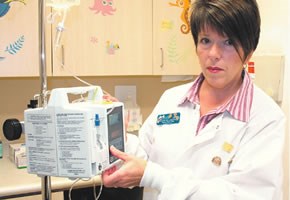BY
TRACEY DUGUAY
While cancer research has made tremendous strides over the
years, for chemotherapy nurse Claire Vaillancourt one of the
most significant improvements has been the creation of new
anti-nausea medications.
"Patients used to stop treatments because they were so ill,"
she explains.
Vaillancourt, who has worked as a chemotherapy nurse for 17
years, says the new drugs are very costly but very
effective. 
The side effects of chemotherapy can include hair loss, nausea,
vomiting, mouth sores, constipation and diarrhea. Blood cells
can be affected leading to infections or bleeding.
One of the most important roles Vaillancourt plays is helping
guide patients through the chemotherapy process.
She, along with the rest of the dedicated team of nurses at the
local cancer centre, is often in the unenviable position of
making patients sick in order to save or prolong their
lives.
"Basically they are well and feel well, then you give them
chemotherapy, and they're very sick," Vaillancourt says.
"It is hard, but you have to realize you're there to support
them with your knowledge of the types of side effects they may
encounter and what they can do about them. You also offer them
encouragement."
Chemotherapy nurses undergo specialized training.
"We all have certification to administer the chemotherapy and
we all belong to an association, the Canadian IV Nurses
Association.
"Most of us are oncology certified which means we have written
the government exam saying we are proficient at giving
chemotherapy."
There are three goals of chemotherapy treatment. One is to cure
the cancer, meaning the tumor or cancer is eradicated and
doesn't return.
The second, adjuvant treatment, is to control the cancer and
stop it from spreading. This type of treatment often follows
surgery and is used to kill off any cancerous cells left behind
that can't be seen on an X-ray or CAT scan. The last type of
treatment is palliative, usually given if the cancer has
reached an advanced stage, and the chemotherapy is used to slow
the progress of the disease and help prolong the life of the
patient.
Patients receiving the first two types of treatment could spend
the next four to six months on an outpatient basis receiving
chemotherapy, which is administered according to a treatment
plan set out by their oncologist. Some patients receive it
daily for a week, then have three weeks off, other may come in
once a week for weeks at a time.
For palliative care patients, they receive chemotherapy
treatments on and off for the rest of their lives.  Since
chemotherapy affects good cells along with the cancerous ones,
the breaks between treatments are needed in order to allow the
good cells to repair themselves.
While undergoing chemotherapy, patients can spend anywhere from
30 minutes to six or seven hours in the treatment room, which
gives the nurses plenty of time to get to know them
individually.
This relationship is one of the things Vaillancourt likes the
most about her job.  
"I enjoy working with the patients. They're very giving,
they're very appreciative of everything you do for them," she
says.
"It's a very relaxed atmosphere in the chemotherapy room and
you have one-on-one consults, discussing and teaching them
about their treatments, and you just have nice conversations
with them."
With the chemotheraphy chairs situated close together in an
open concept setting, many patients, especially those whose
treatments times coincide, form a supportive relationship with
one another as well.
"They look out for one another," Vaillancourt says. "It's like
a big family in there sometimes."
Short of a complete cure, when it comes to future cancer
research, Vaillancourt hopes scientists eventually find a way
to only target the bad cancerous cells, thereby reducing the
harmful effects of chemotherapy on the good ones.
October is Breast Cancer Awareness Month in Canada.  The Luncheon for Hope fundraiser, which takes place next Friday and features guest speaker Marlo Shapiro, is already sold out. This annual event is an initiative of the Northern Cancer Research Foundation, with proceeds supporting local breast cancer research.
